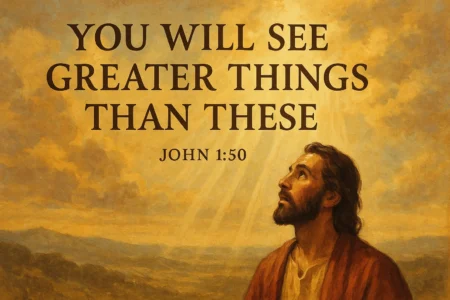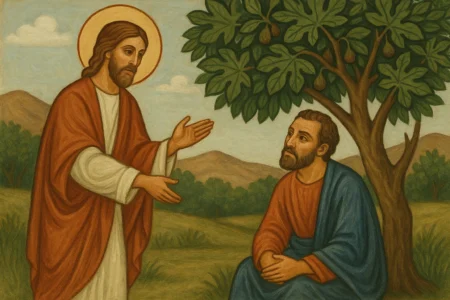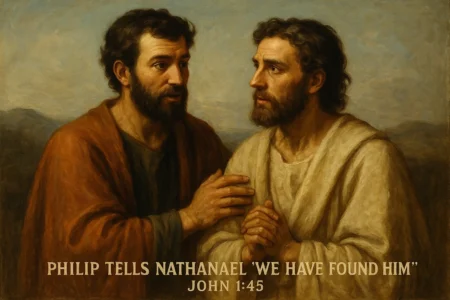Have you ever read a verse in the Bible that just stops you in your tracks?
A line so dense and visual that you know it’s a big deal, but you can’t quite unlock it? For me, John 1:51 is one of those verses. It’s the stunning conclusion to Jesus’s very first encounters with His disciples. After a remarkable exchange with a skeptic named Nathanael, Jesus looks at him and says, “Truly, truly, I say to you, you will see heaven opened, and the angels of God ascending and descending on the Son of Man.”
It’s a mic-drop moment.
What on earth did He mean? Angels on a ladder… but on Him? This is far more than just a beautiful piece of poetry. It’s one of the most profound and foundational claims Jesus ever made about His own identity. Understanding the John 1:51 meaning is like finding a master key that unlocks not only the Gospel of John but the entire story of the Bible. It’s the moment Jesus lays His cards on the table and declares, “I am the bridge between heaven and earth.”
Let’s unpack this together.
More in John Chapter 1 Category
Here’s the Core of It (Key Takeaways)
- The John 1:51 meaning hinges on one thing: Jacob’s Ladder. Jesus is making a direct, intentional callback to that famous story in Genesis 28, a story every Jewish person would know by heart.
- He’s not just referencing the story; He’s replacing it. Jesus radically reinterprets this vision by identifying Himself—”the Son of Man”—as the actual ladder, the real connection.
- This verse is Jesus’s bold declaration that He is the exclusive mediator. He is the one and only access point between God in heaven and us down here on earth.
- The image of “angels ascending and descending” on Him signifies that all divine communication, all heavenly ministry, and all of God’s activity now centers on and passes through the person of Jesus Christ.
- This was the first of the “greater things” Jesus promised Nathanael. It was designed to shift Nathanael’s faith from “Wow, you have supernatural knowledge” to “Oh my goodness, you are the divine connection to God Himself.”
What Was Happening Right Before Jesus Said This?
To get the full impact, you have to picture the scene. It’s the very beginning of Jesus’s ministry. He’s gathering His first followers. Philip, already convinced, runs to find his friend Nathanael.
Nathanael is a skeptic. He’s blunt.
When Philip says, “We have found the one Moses wrote about… Jesus of Nazareth,” Nathanael’s famous comeback is, “Can anything good come out of Nazareth?”
He’s unimpressed.
Nevertheless, he goes. As he approaches, Jesus sees him and says, “Behold, an Israelite indeed, in whom there is no deceit!” This stuns Nathanael. “How do you know me?” he asks.
Jesus delivers the line that shatters Nathanael’s skepticism: “Before Philip called you, when you were under the fig tree, I saw you.”
We don’t know what Nathanael was doing under that tree. Maybe he was praying, meditating on Scripture, or having a private crisis of faith. Whatever it was, it was private. Jesus’s knowledge was supernaturally intimate. Nathanael’s walls crumble instantly. He makes a massive declaration: “Rabbi, you are the Son of God! You are the King of Israel!”
It’s an amazing confession. But Jesus’s response is what sets up our verse. He essentially says, “That’s all it took? You believe just because I told you I saw you under a tree? That’s nothing. You are about to see so much more.”
And then, He tells him what those “greater things” are: “Truly, truly, I say to you, you will see heaven opened, and the angels of God ascending and descending on the Son of Man.”
Why Does Jesus Bring Up an Old Story from Genesis?
Jesus’s audience, especially a devout Israelite like Nathanael, would have understood this reference immediately. He wasn’t pulling a random image out of thin air. He was directly invoking one of the most famous stories in Jewish history: Jacob’s Ladder.
What Exactly Did Jacob See in His Dream?
To find the source, we have to go all the way back to Genesis 28. Jacob is on the run. He has just deceived his father and stolen his brother Esau’s blessing. He is utterly alone, fleeing for his life, and he stops for the night in a desolate, “certain place.”
He’s a man in trouble, sleeping in the dirt with a rock for a pillow.
I’ve often thought about how desperate and scared he must have felt. He was the heir to God’s covenant promise, but at that moment, he just looked like a fugitive.
And in that lowly state, he has a world-changing dream. He sees a sullam—a Hebrew word that means “ladder” or, more accurately, a “stairway” or “ramp”—set up on the earth, and its top reached all the way into heaven. On this stairway, he sees angels of God “ascending and descending on it.”
And then, the most important part: the LORD Himself stands above it. God speaks to Jacob, renewing the covenant He made with Abraham and Isaac. He promises Jacob land, countless descendants, and a world-blessing mission. Crucially, He says, “Behold, I am with you and will keep you wherever you go.”
What Did Jacob’s Ladder Mean for Israel?
When Jacob wakes up, he is terrified and awestruck. He says, “Surely the LORD is in this place, and I did not know it… How awesome is this place! This is none other than the house of God (in Hebrew, Bethel), and this is the gate of heaven.”
From that day on, “Bethel” became a sacred concept. Jacob’s ladder symbolized God’s grace. It was the tangible, visible proof that God was not hopelessly distant. It showed that there was a connection, a “gate,” between the divine realm and the human world. It was a promise that God communes with His people.
For centuries, this was a cornerstone of Jewish hope. God has a way to reach us.
Heaven is not sealed shut.
So, How Does Jesus “Become” the Ladder?
Now, fast-forward back to John 1. Jesus looks at Nathanael, who just had his “Bethel” moment of discovering God’s presence, and He makes His move. He takes that powerful, sacred image of the ladder and applies it directly to Himself.
But it’s a radical switch.
I remember my first real Bible study as a college freshman. We were tackling the Gospel of John, and I felt completely lost. The leader, a patient guy named Mark, pointed this out. “Look,” he said, “Jacob saw a thing—a ladder. It was a physical-looking object in a specific place. John is telling us that Jesus is the person who is that thing. The connection isn’t a location anymore; it’s a ‘who’.”
That was a lightbulb moment for me.
Jesus isn’t saying, “You’ll see a vision like Jacob’s.” He’s saying, “I am what Jacob’s vision pointed to.” The promise isn’t a new holy place; it’s a new holy person. The John 1:51 meaning is that Jesus Himself is the new Bethel, the new “House of God.”
Why Is This Shift from a Place to a Person So Radical?
You have to understand that for a first-century Jew, God’s presence on earth was tied to a physical location: the Temple in Jerusalem. That was the “House of God,” the one place where sacrifices could be made, where heaven and earth were believed to meet.
Jesus’s claim here is a direct challenge to that entire system.
It’s no accident that in the very next chapter (John 2), Jesus goes to that Temple and says, “Destroy this temple, and in three days I will raise it up.” John, the author, gives us the spoiler: “He was speaking about the temple of his body.”
Jesus is systematically redefining Israel’s most sacred concepts around Himself. Are you waiting for the Temple? I am the Temple. Are you looking for Bethel, the gate of heaven? I am the gate. Are you hoping for the ladder? I am the ladder.
The breathtaking claim of John 1:51 is that access to God, communion with heaven, and all divine activity are no longer found by going to a building in Jerusalem. That access is found only in Him.
What Does “Son of Man” Really Mean Here?
This is another piece of the puzzle. Jesus doesn’t just say the angels are ascending and descending on “me.” He specifically uses the title “the Son of Man.”
This isn’t just a humble way of saying “I’m a human.” It’s one of the most loaded, powerful, and central Messianic titles Jesus ever used.
Is This Just About Jesus Being Human?
Partly, yes. It absolutely affirms His incarnation. The ladder had its base “set on the earth.” Jesus, as the Son of Man, is fully human, fully planted in our world. He is God with us. This vision isn’t about a distant, ghostly spirit; it’s about a connection that is anchored in the flesh-and-blood person of Jesus.
But that’s not the whole story.
Where Does This Title Come From?
The most significant source for this title is the book of Daniel, chapter 7. Daniel has a vision of heavenly judgment. After seeing terrifying “beasts” (representing earthly kingdoms), he sees a new figure arrive.
“I saw in the night visions, and behold, with the clouds of heaven there came one like a son of man, and he came to the Ancient of Days [God] and was presented before him. And to him was given dominion and glory and a kingdom, in order that all peoples, nations, and languages should serve him; his dominion is an everlasting dominion, which shall not pass away.” (Daniel 7:13-14)
This “Son of Man” is a figure who is both human (“son of man”) and divine (he comes on the clouds, is given an eternal kingdom, and is served by all peoples).
So when Jesus uses this title, He’s making a staggering claim. He is identifying Himself as this divine, authoritative ruler from Daniel’s vision. He is the human one who perfectly represents humanity to God, and He is the divine one who perfectly represents God to humanity.
This is why He is the ladder. Only someone who is 100% God and 100% man can bridge the infinite gap between the two. The John 1:51 meaning is that the angels are ascending and descending on Him because He is the God-Man, the sovereign King who connects heaven and earth.
Why Are the Angels “Ascending” First, Then “Descending”?
This is a subtle detail, but it’s brilliant. Doesn’t it seem backward? If angels come from heaven, shouldn’t they descend first, then ascend?
Both Jacob’s dream (in the original Hebrew) and Jesus’s statement list “ascending” first. This is intentional, and it’s not a mistake. It implies a few profound truths.
It suggests that the angels are already on earth (fulfilling the will of God, perhaps even ministering to Jesus) and are now returning to heaven through Him (the ladder) to report. Then, new commands and new missions (descending) are dispatched from the Father back through Him. It shows He is the command center, and that all angelic ministry is now routed through the Son of Man.
It also shows that John is a meticulous author. By matching the order of Genesis 28:12, he is forging an unbreakable link between the “type” (Jacob’s vision) and the “antitype” (Jesus Christ). He’s showing that this has been God’s plan all along.
Ultimately, it emphasizes His authority. The entire flow of divine traffic now goes through Jesus. Nothing passes from heaven to earth, or earth to heaven, except in relation to Him. He is the nexus. He is the mediator of all divine-human communication.
This isn’t a static image. It’s a bustling, two-way superhighway of divine activity. It’s a living, dynamic connection, and Jesus is at the absolute center of it all.
Did Nathanael and the Disciples Ever “See” This Happen?
Jesus made a direct promise: “you will see.” So, did they?
We have no record of Nathanael or the other disciples ever seeing a literal, visual spectacle of angels flying up and down around Jesus’s physical body. But they did see the “greater things” this vision pointed to.
They saw the reality of it.
Jesus’s promise wasn’t for a light show; it was for a revelation of His identity. They saw Him as the ladder.
Think about the rest of the Gospel of John. The disciples saw the miracles. Just a few days later, Jesus turns water into wine. This is a “heavenly” intervention, a creative act of God “descending” into an earthly situation through Jesus. They saw Him heal the sick, walk on water, and feed 5,000 people. Each miracle was a demonstration that heaven was, in fact, “opened” and its power was flowing through Him.
They saw the Transfiguration. Peter, James, and John saw Jesus glorified on a mountain, His face shining like the sun. They saw Moses and Elijah (from heaven) speaking with Him. And they heard the Father’s voice from an “opened heaven” boom, “This is my beloved Son!”
And most of all, they saw the Resurrection and Ascension.
This is the ultimate fulfillment. Jesus descended into death and hell itself, and then ascended back to the Father, blazing a trail for all of us. His resurrection is the ultimate proof that He is the ladder, the one who has conquered the separation between life and death, earth and heaven.
I used to be obsessed with the literalness of this. I’d read John 1:51 and picture a physical ladder crowded with angels in robes. My perspective changed completely after my father passed away a few years ago. In that raw, suffocating grief, the “connection” to heaven felt so desperately broken.
Rereading this verse in that context, I finally understood. The promise wasn’t about a visual spectacle. It was about access. Jesus didn’t promise Nathanael a magic show; He promised that in Him, the line to God is never, ever broken. Not by our skepticism, not by our suffering, not even by death. That’s the “greater thing” I came to see, and it’s infinitely more real and powerful than any literal vision of angels.
What is the John 1:51 Meaning for Us Today?
This isn’t just a 2,000-year-old story for Nathanael. This is the central claim of the Christian faith, and it has massive implications for you and me.
How is Jesus Our “Ladder” Right Now?
This truth is intensely practical. It means that Jesus is our mediator. The writer of 1 Timothy put it this way: “For there is one God, and there is one mediator between God and men, the man Christ Jesus” (1 Timothy 2:5).
Jesus is that mediator. He is that ladder. We don’t need another one.
Because of this, we have direct access in our prayer. We can “approach God’s throne of grace with confidence” (Hebrews 4:16). We don’t have to wonder if our prayers get “lost.” We pray in Jesus’s name, which means we are climbing the ladder He provides, and our prayers are heard by the Father because of Him.
We also have access to truth. The Bible isn’t just an ancient religious text; it is the revelation of the “Word made flesh” (John 1:14). When we read Scripture, we are interacting with the mind of Christ, the ladder who connects heavenly wisdom to our earthly minds.
And we have access to power. The Holy Spirit, the very power of heaven, “descends” to us from the Father, through the Son. He is the one who empowers us to live the Christian life.
This whole concept of Jesus as the sole mediator is a cornerstone of Christian theology. His unique role as the God-man is what makes this all possible. As theologians at Yale Divinity School explore, the dual nature of Christ (both divine and human) is the very “place” where God and humanity are perfectly and permanently reconciled. He isn’t just showing us the way; He is the Way.
The Ladder at the Center of Everything
From the very start of His ministry, Jesus made this audacious claim. He looked at a man who was impressed by a small display of supernatural knowledge and essentially said, “Stick with me, and I’ll show you the entire cosmos.”
He revealed that He wasn’t just a great teacher, a prophet, or even just the “King of Israel.” He was, and is, the single point of contact for all of reality.
The John 1:51 meaning is simple but universe-altering. Jesus is the ladder. He is the bridge. He is the connection. Everything that flows from heaven to earth, and everything that rises from earth to heaven—all prayer, all ministry, all grace, all glory—passes through Him.
He is the gate. He is the house of God. He is the Son of Man, and heaven is wide open.
FAQ – John 1:51 Meaning
Why does Jesus reference Jacob’s Ladder in John 1:51?
Jesus references Jacob’s Ladder to illustrate that He is the new and true connection between heaven and earth, replacing the physical location of the Temple with Himself as the divine mediator and the true gate of heaven.
What does the title ‘Son of Man’ signify in this verse?
The title ‘Son of Man’ signifies Jesus’s dual nature as fully human and divine, referencing the vision in Daniel 7 where the divine ruler is both human and heavenly, affirming His role as the God-Man who bridges the infinite gap between God and humanity.
How do the angels ascending and descending illustrate Jesus’s role?
The angels ascending and descending on Jesus symbolize that all divine communication, ministry, and heavenly activity now center through Him, emphasizing His authority as the mediator and the divine nexus connecting heaven and earth.
What does the promise of seeing heaven opened mean for believers today?
For believers today, it means that access to God is permanently available in Jesus Christ; through Him, we have direct access in prayer, understanding, and power, emphasizing that heaven’s connection is unbreakable and centered in Him.





